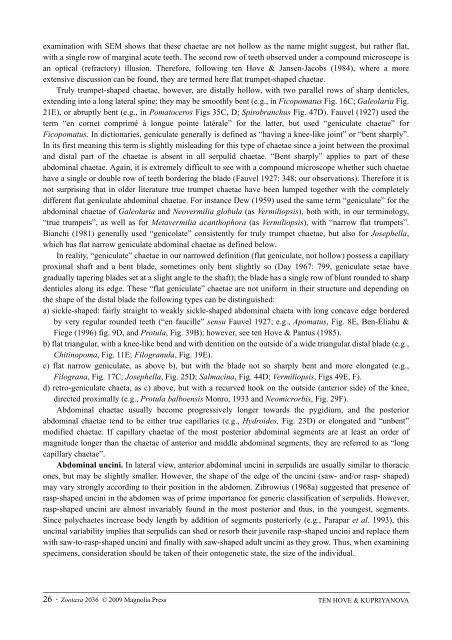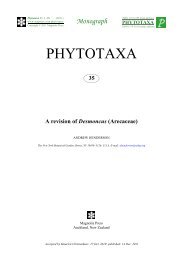Zootaxa, Taxonomy of Serpulidae (Annelida ... - Magnolia Press
Zootaxa, Taxonomy of Serpulidae (Annelida ... - Magnolia Press
Zootaxa, Taxonomy of Serpulidae (Annelida ... - Magnolia Press
You also want an ePaper? Increase the reach of your titles
YUMPU automatically turns print PDFs into web optimized ePapers that Google loves.
examination with SEM shows that these chaetae are not hollow as the name might suggest, but rather flat,<br />
with a single row <strong>of</strong> marginal acute teeth. The second row <strong>of</strong> teeth observed under a compound microscope is<br />
an optical (refractory) illusion. Therefore, following ten Hove & Jansen-Jacobs (1984), where a more<br />
extensive discussion can be found, they are termed here flat trumpet-shaped chaetae.<br />
Truly trumpet-shaped chaetae, however, are distally hollow, with two parallel rows <strong>of</strong> sharp denticles,<br />
extending into a long lateral spine; they may be smoothly bent (e.g., in Ficopomatus Fig. 16C; Galeolaria Fig.<br />
21E), or abruptly bent (e.g., in Pomatoceros Figs 35C, D; Spirobranchus Fig. 47D). Fauvel (1927) used the<br />
term “en cornet comprimé à longue pointe latérale” for the latter, but used “geniculate chaetae” for<br />
Ficopomatus. In dictionaries, geniculate generally is defined as “having a knee-like joint” or “bent sharply”.<br />
In its first meaning this term is slightly misleading for this type <strong>of</strong> chaetae since a joint between the proximal<br />
and distal part <strong>of</strong> the chaetae is absent in all serpulid chaetae. “Bent sharply” applies to part <strong>of</strong> these<br />
abdominal chaetae. Again, it is extremely difficult to see with a compound microscope whether such chaetae<br />
have a single or double row <strong>of</strong> teeth bordering the blade (Fauvel 1927: 348; our observations). Therefore it is<br />
not surprising that in older literature true trumpet chaetae have been lumped together with the completely<br />
different flat geniculate abdominal chaetae. For instance Dew (1959) used the same term “geniculate” for the<br />
abdominal chaetae <strong>of</strong> Galeolaria and Neovermilia globula (as Vermiliopsis), both with, in our terminology,<br />
“true trumpets”, as well as for Metavermilia acanthophora (as Vermiliopsis), with “narrow flat trumpets”.<br />
Bianchi (1981) generally used “genicolate” consistently for truly trumpet chaetae, but also for Josephella,<br />
which has flat narrow geniculate abdominal chaetae as defined below.<br />
In reality, “geniculate” chaetae in our narrowed definition (flat geniculate, not hollow) possess a capillary<br />
proximal shaft and a bent blade, sometimes only bent slightly so (Day 1967: 799, geniculate setae have<br />
gradually tapering blades set at a slight angle to the shaft); the blade has a single row <strong>of</strong> blunt rounded to sharp<br />
denticles along its edge. These “flat geniculate” chaetae are not uniform in their structure and depending on<br />
the shape <strong>of</strong> the distal blade the following types can be distinguished:<br />
a) sickle-shaped: fairly straight to weakly sickle-shaped abdominal chaeta with long concave edge bordered<br />
by very regular rounded teeth (“en faucille” sensu Fauvel 1927; e.g., Apomatus, Fig. 8E, Ben-Eliahu &<br />
Fiege (1996) fig. 9D, and Protula, Fig. 39B); however, see ten Hove & Pantus (1985).<br />
b) flat triangular, with a knee-like bend and with dentition on the outside <strong>of</strong> a wide triangular distal blade (e.g.,<br />
Chitinopoma, Fig. 11E; Filogranula, Fig. 19E).<br />
c) flat narrow geniculate, as above b), but with the blade not so sharply bent and more elongated (e.g.,<br />
Filograna, Fig. 17C; Josephella, Fig. 25D; Salmacina, Fig. 44D; Vermiliopsis, Figs 49E, F).<br />
d) retro-geniculate chaeta, as c) above, but with a recurved hook on the outside (anterior side) <strong>of</strong> the knee,<br />
directed proximally (e.g., Protula balboensis Monro, 1933 and Neomicrorbis, Fig. 29F).<br />
Abdominal chaetae usually become progressively longer towards the pygidium, and the posterior<br />
abdominal chaetae tend to be either true capillaries (e.g., Hydroides, Fig. 23D) or elongated and “unbent”<br />
modified chaetae. If capillary chaetae <strong>of</strong> the most posterior abdominal segments are at least an order <strong>of</strong><br />
magnitude longer than the chaetae <strong>of</strong> anterior and middle abdominal segments, they are referred to as “long<br />
capillary chaetae”.<br />
Abdominal uncini. In lateral view, anterior abdominal uncini in serpulids are usually similar to thoracic<br />
ones, but may be slightly smaller. However, the shape <strong>of</strong> the edge <strong>of</strong> the uncini (saw- and/or rasp- shaped)<br />
may vary strongly according to their position in the abdomen. Zibrowius (1968a) suggested that presence <strong>of</strong><br />
rasp-shaped uncini in the abdomen was <strong>of</strong> prime importance for generic classification <strong>of</strong> serpulids. However,<br />
rasp-shaped uncini are almost invariably found in the most posterior and thus, in the youngest, segments.<br />
Since polychaetes increase body length by addition <strong>of</strong> segments posteriorly (e.g., Parapar et al. 1993), this<br />
uncinal variability implies that serpulids can shed or resorb their juvenile rasp-shaped uncini and replace them<br />
with saw-to-rasp-shaped uncini and finally with saw-shaped adult uncini as they grow. Thus, when examining<br />
specimens, consideration should be taken <strong>of</strong> their ontogenetic state, the size <strong>of</strong> the individual.<br />
26 · <strong>Zootaxa</strong> 2036 © 2009 <strong>Magnolia</strong> <strong>Press</strong><br />
TEN HOVE & KUPRIYANOVA
















